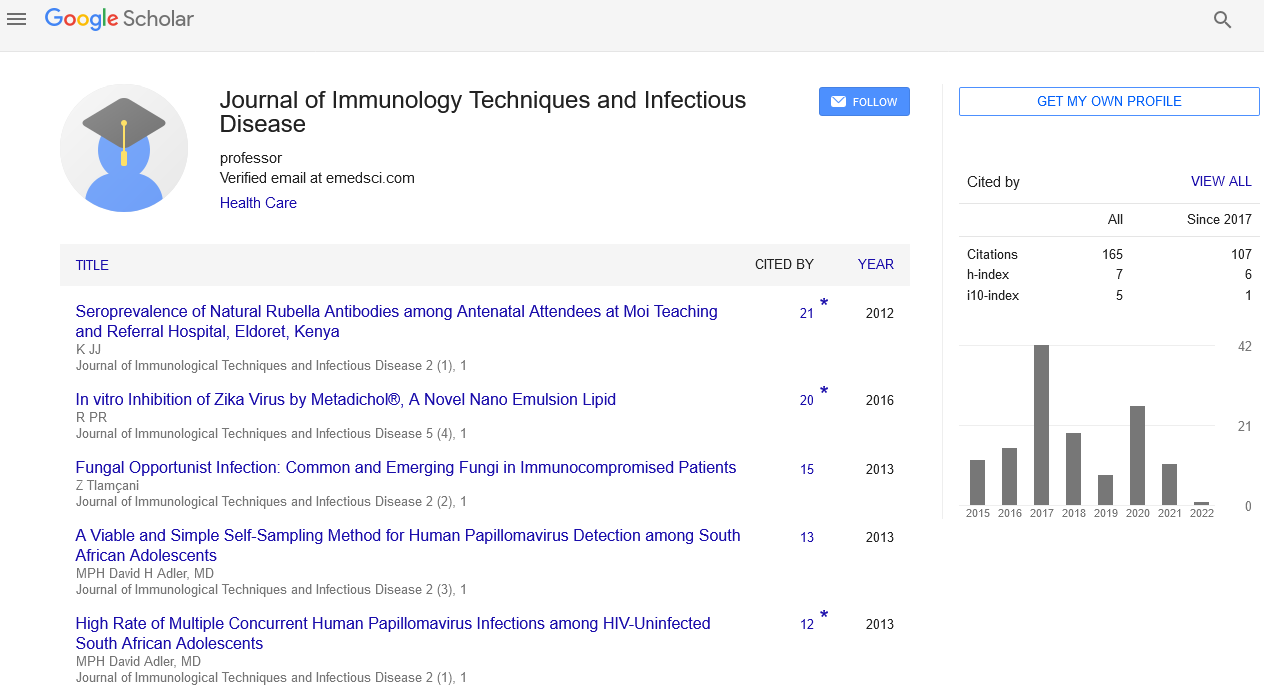Perspective, J Immunol Tech Infect Dis Vol: 13 Issue: 3
Preventing Disease through Child Immunization: Reducing Risks and Protecting Lives
Zhang Huang*
1Department of Medicine, Children’s Hospital, Nanning, China
*Corresponding Author: Zhang Huang,
Department of Medicine, Children’s
Hospital, Nanning, China
E-mail: huangzhang@edu.cn
Received date: 26 August, 2024, Manuscript No. JIDIT-24-151945;
Editor assigned date: 28 August, 2024, PreQC No. JIDIT-24-151945 (PQ);
Reviewed date: 11 September, 2024, QC No. JIDIT-24-151945;
Revised date: 18 September, 2024, Manuscript No. JIDIT-24-151945 (R);
Published date: 25 September, 2024, DOI: 10.4172/2329-9541.1000387
Citation: Huang Z (2024) Preventing Disease through Child Immunization: Reducing Risks and Protecting Lives. J Immunol Tech Infect Dis 13:3.
Description
Pediatric Child immunization is one of the most significant public health interventions that have effectively reduced the prevalence of numerous infectious diseases worldwide. By exposing children’s immune systems to safe versions of disease-causing pathogens, vaccines develop the body to fight against certain illnesses that can develop in the future. This not only protects the individual child but also contributes to increase immunity, reducing the spread of infections within the community.
The importance of child immunization
Vaccines have helped to prevent millions of lives by reducing diseases that used to affect adolescents and generate epidemics in the entire community. Before the widespread use of vaccines diseases such as measles, polio, diphtheria and whooping cough caused high child mortality rates and permanent disabilities. Immunization helps in two main ways: It directly protects vaccinated individuals from specific diseases and contributes to increased immunity, when the population has a high vaccination rate, diseases spread more slowly, even to people who are unable to obtain vaccination.
Childhood infections, particularly those caused by viruses and bacteria, can result in serious complications, such as pneumonia, encephalitis (brain inflammation) and septicemia (blood infection). Immunization drastically reduces the risk of these diseases, providing protection that may last a lifetime. For example, the measles vaccine has prevented thousands of cases of measles-related complications and deaths.
Immunization prevents infections that would otherwise require medical attention, hospitalization and possibly long-term treatment.
By reducing the incidence of these diseases, immunization reduces the financial burden on healthcare systems and families, especially in lowincome settings where resources are limited.
The immunization schedule and the way it works
Child immunization schedules are designed to protect children from diseases as early as possible, generally before they are exposed to lifethreatening pathogens. In most countries, national health agencies and organizations such as the World Health Organization (WHO) and Centers for Disease Control (CDC) and prevention provide immunization schedules that recommend specific vaccines at certain ages.
Birth to 6 months: This period includes the first set of fundamental vaccinations that protect against hepatitis B, diphtheria, tetanus, pertussis (whooping cough), Haemophilus Influenzae Type b (Hib), polio and pneumococcal infections. For example, the hepatitis B vaccine is frequently administered shortly after birth to prevent liver disease, which can have severe consequences in infants.
6 to 18 months: During this time, children receive boosters for earlier vaccinations, such as DTaP (diphtheria, tetanus and pertussis) and polio and new vaccines such as the MMR (measles, mumps and rubella) vaccine. These immunizations are especially important since children are more probable to participate in social activities and become susceptible to diseases.
4 to 6 years: Before entering school, children receive additional boosters for vaccines such as DTaP, MMR and polio, which help to reinforce immunity as they start to spend more time in larger groups, such as in daycare or school settings.
Pre-adolescence and adolescence (11–12 years and older): Certain vaccines, such as the Human Papillomavirus (HPV) vaccine and the meningococcal vaccine, are recommended during preadolescence to protect against infections they may encounter as they grow older. HPV vaccination is particularly important as it protects against certain types of cancers caused by the virus.
Child immunization remains a foundation of public health, providing essential protection against serious diseases that can lead to severe illness, complications and even death. Vaccination not only protects individual children but also contributes to the well-being of entire communities by reducing the spread of infectious diseases. Despite challenges such as misinformation and access issues, ongoing efforts in education, infrastructure and studies are important to maintaining and improving immunization rates. By following recommended immunization schedules and supporting vaccine accessibility, societies can safeguard future generations from preventable diseases, ensuring healthier lives and a safer public health environment for every person.
 Spanish
Spanish  Chinese
Chinese  Russian
Russian  German
German  French
French  Japanese
Japanese  Portuguese
Portuguese  Hindi
Hindi 
